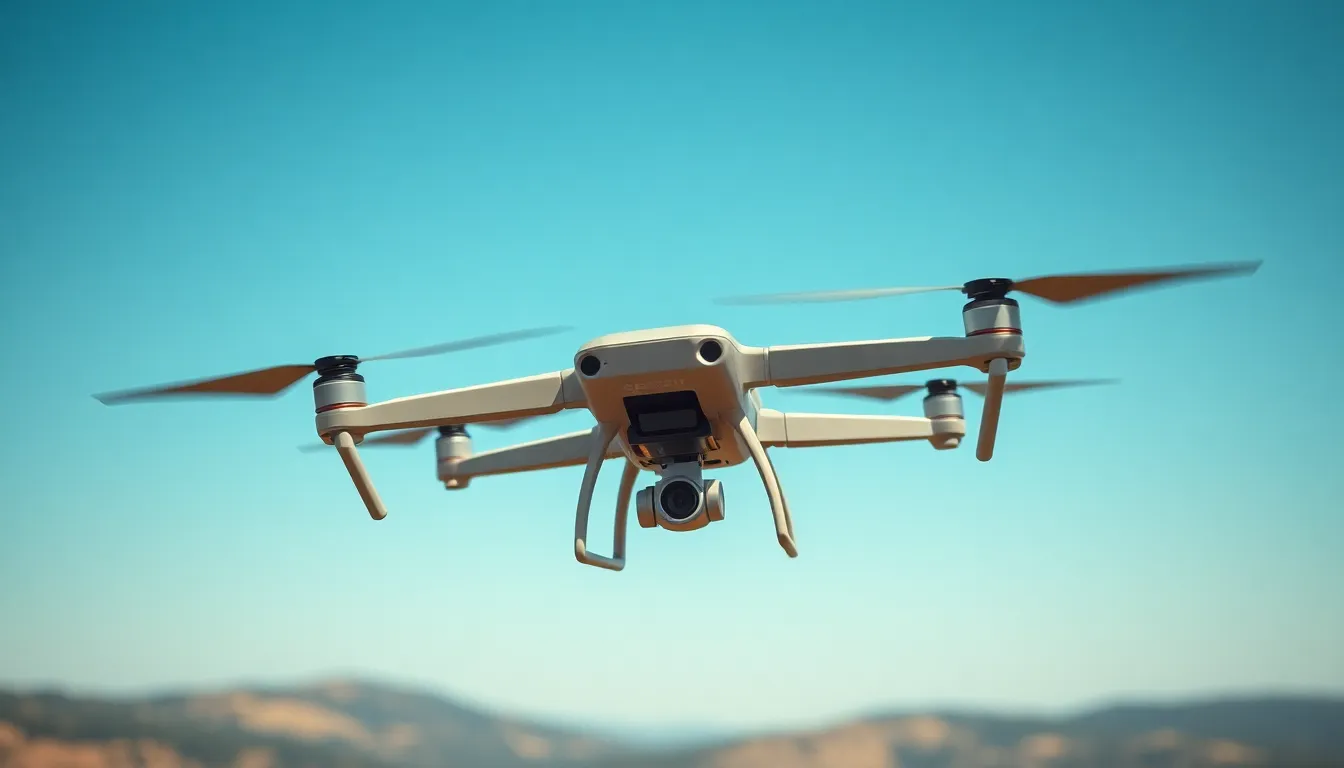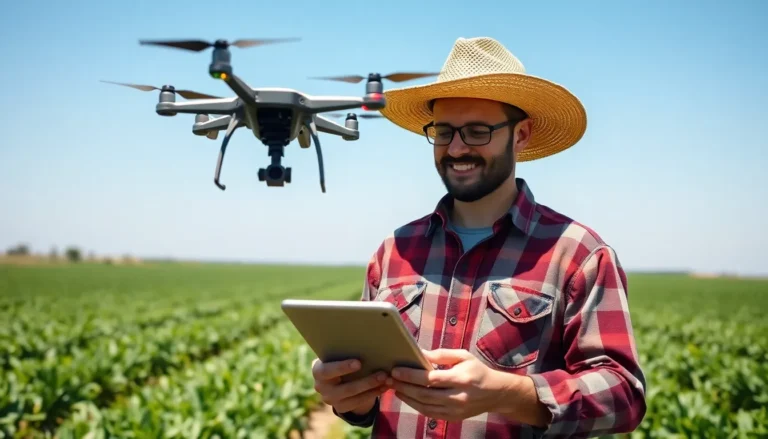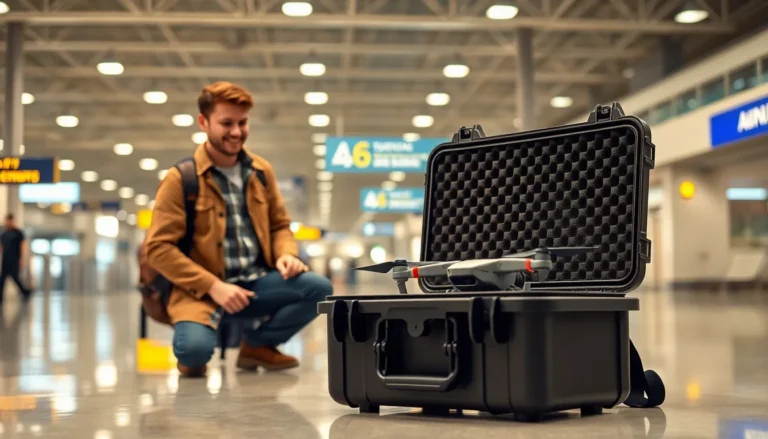Drones aren’t just for capturing stunning aerial selfies anymore; they’ve evolved into the ultimate flying machines with skills that would make even a seasoned pilot envious. Imagine sending your drone into a dizzying spiral or watching it effortlessly dance through an obstacle course. Advanced drone maneuvers aren’t just impressive—they’re the secret sauce that takes a hobbyist from “meh” to “wow” in the blink of an eye.
Table of Contents
ToggleOverview of Advanced Drone Maneuvers
Advanced drone maneuvers encompass a variety of techniques designed to enhance flying capabilities and showcase aerial artistry. Pilots often utilize flips and rolls, which involve the drone executing rapid rotations along its axes. This technique adds excitement and impresses viewers during flight demonstrations.
Additionally, precise hovering is crucial for capturing still images or videos. Maintaining a stable position allows operators to achieve high-quality footage, which is essential for filmmakers and content creators.
Another impressive maneuver is the figure-eight flight path, which combines both skill and control. Completing figure-eights involves navigating the drone in a continuous, looping pattern. This maneuver not only improves coordination but also tests the pilot’s ability to manage altitude changes and turning radii effectively.
In complex scenarios, pilots frequently employ waypoint flying. This technique utilizes GPS coordinates to define a flight path, allowing the drone to fly autonomously. Waypoint flying suits applications like mapping and surveying, converting tedious tasks into efficient, automated processes.
Moreover, drone racing introduces another layer of excitement. In this context, pilots must master sharp turns and quick accelerations. Racing requires not only speed but also precision, as competitors navigate through tight courses marked by gates or obstacles.
Lastly, inverted flight pushes the limits of drone control. This maneuver necessitates an understanding of the drone’s dynamics as it flies upside down. Mastery of inverted flight indicates a pilot’s advanced skill level and enhances various flying experiences.
These advanced maneuvers contribute to an enriched flying experience, transforming ordinary flights into extraordinary displays of aerial capability.
Types of Advanced Drone Maneuvers

Advanced drone maneuvers showcase a pilot’s expertise and elevate aerial performances. Below are various types that highlight unique capabilities.
Autonomous Flight Patterns
Autonomous flight patterns utilize GPS technology, enabling drones to follow predetermined routes without manual input. This feature enhances efficiency for tasks such as mapping and surveying. Drones equipped with follow-me modes autonomously adjust their flight paths based on the subject’s movements. They create intricate paths by combining waypoints, ensuring precision in capturing scenic shots or conducting inspections. These capabilities simplify complex tasks and minimize pilot workload.
Aerial Acrobatics
Aerial acrobatics involve stunning maneuvers like flips, rolls, and barrel turns, captivating audiences during flight demonstrations. Pilots must combine precision and control to perform these stunts successfully. These maneuvers showcase drone stability and a pilot’s skill level. Some aerial tricks not only impress but also test drone capabilities under varying conditions, including speed and wind. Mastering these acrobatics transforms regular flights into exciting performances that thrill onlookers.
Precision Landing Techniques
Precision landing techniques enhance the ability to land drones safely in tight spaces. Drones use visual positioning systems to identify landing spots, ensuring consistent accuracy. Features like one-touch landing simplify the landing process, reducing potential accidents. Enhanced sensors allow for adjustments mid-flight, ensuring a gentle touchdown. Mastering precision landings benefits both photography enthusiasts and commercial operators, as it minimizes damage risk and operational downtime.
Benefits of Mastering Advanced Drone Maneuvers
Mastering advanced drone maneuvers offers several advantages, enhancing the overall flying experience.
Enhanced Flight Control
Improved flight control results from mastering techniques like flips and precision hovering. Pilots gain the ability to perform complex movements with confidence. A strong command over advanced maneuvers leads to better response times during flight. This agility plays a crucial role in executing intricate tasks seamlessly. Precision enables drone pilots to capture high-quality aerial footage effortlessly. For racing enthusiasts, enhanced control helps navigate sharp turns and quick accelerations, elevating performance in competitive scenarios.
Increased Safety Measures
Increased safety measures significantly stem from proficiency in advanced techniques. Pilots practicing precision landing further minimize the risk of accidents during landings. Understanding advanced flight patterns allows for better situational awareness while flying. Familiarity with inverted flight makes emergency recovery more manageable, keeping drones stable during unexpected situations. Autonomy through waypoint flying enhances safety in navigation, particularly in challenging environments. Overall, enhanced skills provide confidence in handling potential hazards, ensuring a more secure flying experience.
Training for Advanced Drone Maneuvers
Training for advanced drone maneuvers involves a combination of online courses, practical exercises, and dedicated practice. These methods provide comprehensive guidance for both newcomers and experienced pilots.
Online Courses and Resources
Numerous online courses focus on advanced drone maneuvers, catering to different skill levels. Platforms like Udemy and Coursera offer specific classes on aerial acrobatics and precision flying. Users can access videos and tutorials for flexible learning experiences. Additional resources, such as forums and YouTube channels, offer valuable tips from industry experts. Many drone manufacturers also provide training materials that cover their specific models. This wealth of information supports a pilot’s journey to mastering advanced techniques.
Practical Flight Exercises
Pilots can enhance their skills through practical flight exercises designed for advanced maneuvers. These exercises often include flipping, rolling, and autonomous waypoint navigation. Establishing a safe and open environment allows for focused practice. Engaging in drone racing activities helps improve responsiveness and control during sharp turns. Frequent practice of precision landing techniques ensures safety and efficiency in varied environments. Experimenting with inverted flight builds confidence and control, crucial for professionals and enthusiasts. Regular practice solidifies the connection between theory and execution, leading to better performance in the field.
Mastering advanced drone maneuvers opens up a world of possibilities for pilots. It transforms ordinary flying into an exhilarating experience filled with creativity and precision. By honing skills like flips, precision hovering, and waypoint navigation, pilots not only enhance their control but also elevate the safety and enjoyment of their flights.
Regular practice and training are crucial for achieving proficiency. With the right resources and dedication, anyone can learn to perform stunning aerial displays or navigate tight spaces with confidence. As drone technology continues to evolve, the potential for impressive maneuvers will only grow, making it an exciting time for enthusiasts and professionals alike.





